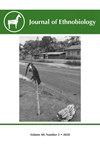From “Cycad Hell” to Sacred Landscapes: Tracing the Cultural Significance of Cycads in the Ryukyu Islands and Japan
IF 1.3
3区 社会学
Q1 ANTHROPOLOGY
引用次数: 1
Abstract
This article explores the place of Cycas revoluta in Japanese culture, with a specific focus on the Ryukyu archipelago. Although never domesticated, worldwide evidence points to the sustained alimentary, ethnoecological, and symbolic significance of this ancient order of plants since at least the Pleistocene-Holocene transition. Their millennial use in the Ryukyu Islands is a key example of this pattern. Despite this fact, the role of cycads in Ryukyuan and wider Japanese and East Asian cultural systems remains understudied; the broader features of this intriguing aspect of regional culture are virtually unknown outside Japan. This article reviews the social and environmental roles of cycads in ancient and modern Ryukyuan and Japanese cultures, with particular emphasis on their position in indigenous agroecological systems and their incorporation in the sacred landscapes of Buddhist and Shintō religious complexes. In doing so, this article highlights a unique biocultural patrimony and set of ancestral traditions that are in danger of being lost, as cycad habitats succumb to development and as the symbolic significance of cycad use fades from social memory. It concludes with a discussion of how the study of cycads may contribute to contemporary interdisciplinary research and wider heritage discourse to enhance the preservation of the practices, histories, and values related to Japanese cycad culture.从“苏铁地狱”到神圣景观:追踪琉球群岛和日本苏铁人的文化意义
本文探讨了苏铁在日本文化中的地位,特别关注琉球群岛。尽管从未被驯化,但世界范围内的证据表明,至少从更新世到全新世的过渡时期起,这种古老的植物目就具有持续的营养、民族生态学和象征意义。它们在琉球群岛上的千年使用就是这种模式的一个关键例子。尽管如此,苏铁在琉球和更广泛的日本和东亚文化系统中的作用仍未得到充分研究;在日本之外,人们几乎不知道这种地域文化的更广泛特征。本文回顾了苏铁在古代和现代琉球和日本文化中的社会和环境作用,特别强调了它们在本土农业生态系统中的地位,以及它们在佛教和信教建筑群的神圣景观中的地位。在这样做的过程中,本文强调了一种独特的生物文化遗产和一套祖先的传统,随着苏铁栖息地的发展和苏铁使用的象征意义逐渐从社会记忆中消失,这些遗产和传统正面临着失去的危险。文章最后讨论了苏铁的研究如何有助于当代跨学科研究和更广泛的遗产话语,以加强对日本苏铁文化的实践、历史和价值的保护。
本文章由计算机程序翻译,如有差异,请以英文原文为准。
求助全文
约1分钟内获得全文
求助全文
来源期刊

Journal of Ethnobiology
Social Sciences-Anthropology
CiteScore
4.80
自引率
3.40%
发文量
21
审稿时长
>12 weeks
期刊介绍:
JoE’s readership is as wide and diverse as ethnobiology itself, with readers spanning from both the natural and social sciences. Not surprisingly, a glance at the papers published in the Journal reveals the depth and breadth of topics, extending from studies in archaeology and the origins of agriculture, to folk classification systems, to food composition, plants, birds, mammals, fungi and everything in between.
Research areas published in JoE include but are not limited to neo- and paleo-ethnobiology, zooarchaeology, ethnobotany, ethnozoology, ethnopharmacology, ethnoecology, linguistic ethnobiology, human paleoecology, and many other related fields of study within anthropology and biology, such as taxonomy, conservation biology, ethnography, political ecology, and cognitive and cultural anthropology.
JoE does not limit itself to a single perspective, approach or discipline, but seeks to represent the full spectrum and wide diversity of the field of ethnobiology, including cognitive, symbolic, linguistic, ecological, and economic aspects of human interactions with our living world. Articles that significantly advance ethnobiological theory and/or methodology are particularly welcome, as well as studies bridging across disciplines and knowledge systems. JoE does not publish uncontextualized data such as species lists; appropriate submissions must elaborate on the ethnobiological context of findings.
 求助内容:
求助内容: 应助结果提醒方式:
应助结果提醒方式:


